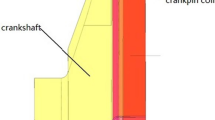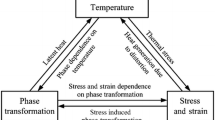Abstract
A finite element model of a diesel engine crankshaft is established with ANSYS and FE-SAFE softwares. Then, the bending moment and fatigue life of crankshaft bending are calculated. Finally, the crankshaft bending fatigue test is carried out on test bench, both the simulation results of the finite element software and experimental results are consistent, and the results show that the combination method of simulation software and bench test proves the journal fillet of crankshaft connecting rod is the weakest part of crankshaft bending fatigue, and it provides an important significance for the design and production of crankshaft.
Access provided by Autonomous University of Puebla. Download conference paper PDF
Similar content being viewed by others
Keywords
12.1 Introduction
Crankshaft is one of the most important parts of an internal combustion engine, its main function is to transfer and output power, under the gas pressure inside the cylinder, reciprocating and rotating inertia force, torque, etc., and it is of great significance for the reliability and performance of the diesel engine [1]. The actual analysis of crankshaft fracture has proved that the failure modes of the crankshaft are mainly bending fatigue damage. In this paper, a diesel engine crankshaft is studied by using ANSYS/FE-SAFE software, the crankshaft stress and fatigue is simulated, and then, the crankshaft bending fatigue test is used for verification, in order to improve the crankshaft fatigue performance and provide important and significant guide.
12.2 Finite Element Stress Analysis
In this study, 3D entity design of crankshaft is firstly built by using Pro/E software; one crank unit of the crankshaft is taken as the analysis object; then, through the interface between ANSYS and Pro/E, the solid model is imported into ANSYS software; and finally, the material parameters of crankshaft listed in Table 12.1 are input simulation software.
12.2.1 Meshing
The finite element model is meshed in the ANSYS software. During the meshing process, select the solid 186 to provide 20-node hexahedron unit. Crankshaft fillet and oil hole, oil position is sensitive to local stress concentration; in these local grid the refinement need to be done [2], as shown in Figs. 12.1 and 12.2, the local grid refinement of crank fillet, the whole finite element model is composed of a total of 473,839 nodes, and 298,686 units.
12.2.2 Applied Load
Under the gas pressure and the inertial force of piston and connecting rod reciprocating motion, the actual operation of crankshaft is extremely complex. In order to analyze the crankshaft bending moment on the crank shaft force, combined with the name of the crankshaft bending moment calculation results of the work, to transform applied load at the other end of the main journal, the given bending moment is 6 kN m. The freedom constraints in different directions are applied on the main journal and at the end of the journal of the connecting rod.
12.2.3 Stress Analysis
As shown in Figs. 12.3 and 12.4, the maximum strain value of static analysis of crankshaft is 0.707 mm; the maximum Von Mises stress distribution on the journal fillet of the connecting rod is 605 MPa, which is significantly higher than the other positions.
12.3 The Calculation of Fatigue Life by ANSYS/FE-SAFE
ANSYS analysis results are imported into the FE-SAFE fatigue life calculation software [3]. This paper uses the ANSYS/FE-SAFE Seeger material data estimation method [4].
In the setting of fatigue calculation, according to the manufacturing process, the crankshaft surface roughness is: 0.6 μm < Ra < l. 6 μm. In FE-SAFE data file window, import load time history curve, select analyses uniaxial stress–life curve von Miss–Goodman algorithm, the application of Miner linear cumulative damage rule, after the input intensity limit and modulus of elasticity, the S–N fatigue life curve of 42CrMo is displayed (as shown in Fig. 12.5).
As shown in Fig. 12.6, through ANSYS post-processing, the crankshaft fatigue life is shown in the form of cloud pictures. The weakest failure position in crankshaft bending fatigue is connecting rod’s journal fillet area, and the shortest fatigue life is N = 104.937 = 86,497 times.
12.4 The Crankshaft Bending Fatigue Test
In the crankshaft fatigue strength of the study, calculation and experiment are two main methods; fatigue test is an effective method for evaluation of the crankshaft structural strength [5]. In this paper, fatigue test was done on the crankshaft bending fatigue test bench (as shown in Fig. 12.7) and the design of bend fatigue test is the main location of evaluation on crankshaft main bear bending load effect. The test bench is magnetic resonance vibration table, with dynamic test frequency up to 35–300 Hz, and it features good reliability, high precision, and strong anti-interference ability.
In this paper, the single crank is used, and thus, you must cut the crankshaft into a crank unit, including a connecting rod journal and two main journals. Crankshaft sample is applied in 6 kN m dynamic load, stress ratio R = −0.2, and under the action of sinusoidal cyclic loading experiment.
As shown in Fig. 12.8, after 149,000 times of the cyclic test, some cracks appears on the crankshaft bending test sample and are just located at the journal fillet of the connecting rod, and the actual fractures are highly consistent with those ones computed by FE-SAFE. All the actual processing of the crankshaft, main journal and connecting rod journal are made by induction hardening processing, tensile strength and fatigue limit equivalent also get bigger, and thus, the actual service life of the crankshaft will be greater than the compute life.
12.5 Conclusions
In this paper, finite element analysis of crankshaft bending stress and fatigue are made through joint application of software PROE, ANSYS, and FE-SAFE; the test bench for crankshaft bending fatigue test is carried out; the following are the conclusions:
Finite element calculation of the fatigue model established by 3D software is feasible, reasonable, and proper.
The simulation result is consistent with the actual test result; those prove the journal fillet of the crankshaft connecting rod is the weakest part of the crankshaft bending fatigue damage.
The combining methods of numerical simulation and bench fatigue test, especially in the design stage of the crankshaft, can avoid the consumption of the time and material in the experimental study, also improve the crankshaft design accuracy, and provide the reliable basis for strengthening the crankshaft fatigue life.
References
Yang LS (1984) The internal combustion engine design. China Agricultural Machinery Press, Beijing
Guo L (2009) Investigation on powertrain structure’s vibration and noise performance based on virtual forecast technology. Zhejiang University, Hangzhou
Jiang NC (2006) ANSYS and ANSYS/FE-SAFE software engineering application and example. Hehai University Press, Nanjing
Peter A (2009) A critical review of the Baumel-Seeger method for estimating the strain-life fatigue properties of metallic materials. Eng Integrity 10(27):6–11
Zhou X (2003) The crankshaft bending fatigue test system research and development. Zhejiang University, Hangzhou
Author information
Authors and Affiliations
Corresponding author
Editor information
Editors and Affiliations
Rights and permissions
Copyright information
© 2015 Springer-Verlag Berlin Heidelberg
About this paper
Cite this paper
Teng, S. et al. (2015). Study on the Bending Fatigue of a Diesel Engine Crankshaft. In: Proceedings of SAE-China Congress 2014: Selected Papers. Lecture Notes in Electrical Engineering, vol 328. Springer, Berlin, Heidelberg. https://doi.org/10.1007/978-3-662-45043-7_12
Download citation
DOI: https://doi.org/10.1007/978-3-662-45043-7_12
Published:
Publisher Name: Springer, Berlin, Heidelberg
Print ISBN: 978-3-662-45042-0
Online ISBN: 978-3-662-45043-7
eBook Packages: EngineeringEngineering (R0)












